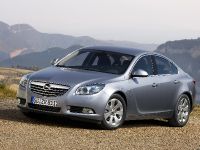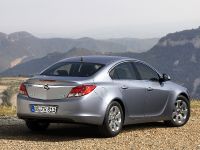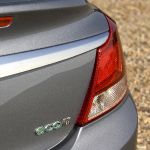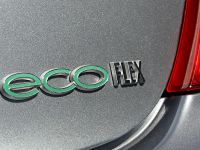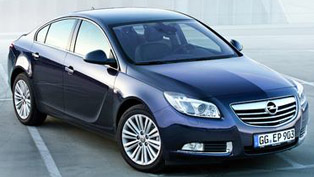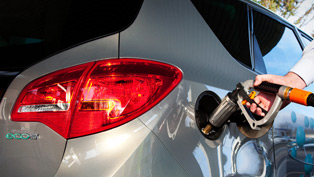Economy without Compromise: Opel Insignia ecoFLEX
The new Insignia ecoFLEX, debuting at the Paris Motor Show (October 4 - 19), offers environmentally friendly driving without making any compromises. In contrast to many other competitors, it is not a low-end model, but rather combines powerful propulsion and driving fun with highest efficiency. Opel's newest ecoFLEX model features a powerful single turbo diesel with 2.0-liter displacement and output of 118 kW/160 hp."We designed the Insignia as a particularly efficient car from the beginning. By making a multitude of detailed improvements to the powertrain and to the road and wind resistance factors of the ecoFLEX model, our engineers are able to minimize consumption without affecting driving fun," says Hans Demant, Managing Director of Adam Opel GmbH. "Though we are still developing the new Insignia ecoFLEX with the 2.0 CDTI ECOTEC engine, we are confident it will emit CO2 gases well below 140 g/km."
Compared to competitor's cars with similar fuel consumption emissions, it is clear why the Opel Insignia ecoFLEX motto is economy without compromise: The efficient use of diesel fuel comes at no cost to driving performance. The Insignia ecoFLEX sprints from zero to 100 km/h in 9.5 seconds and reaches a top speed of up to 218 km/h. Ensuring excellent pulling power even at low rpm, the maximum torque of 350 Nm is available from 1750 rpm, and can be temporarily increased for 15 seconds to 380 Nm via an ‘overboost' function.
The new 2.0-liter common-rail four-cylinder unit uses the innovative clean tech process to ensure the lowest possible emissions are precisely maintained over its life span. This controls combustion via an electronic closed-loop system, adapting fuel injection to combustion development in real time. Piezo-resistive cylinder pressure sensors integrated in the glow plugs are used to measure combustion pressures as high as 180 bar in each individual cylinder up to one million times per minute, within an accuracy of ninety-eight percent. The data is sent to the central engine control system, which accordingly adjusts the volume and timing of the fuel injections. This closed loop system ensures the engine always operates with optimum efficiency and minimal exhaust emissions. Over the entire lifecycle of the Insignia, it compensates for wear factors such as inaccuracies in the fuel metering, component tolerances, varying fuel qualities and operating conditions.
The Insignia ecoFLEX is fitted with highly fuel-efficient Primacy HP tires from Michelin specially developed for the car. Like all Insignia models, the new ecoFLEX variant is Euro 5 certified and will be available as a hatchback and notchback during the course of 2009.
Especially Streamlined: Further improved aerodynamics
Thanks to their streamlined design, sporty roofline and finely-tuned details, the regular Insignia variants feature an exemplary drag factor of 0.27. The Insignia ecoFLEX undercuts even this great figure. On the way to achieving this, Opel was able to tap decades of experience in aerodynamics. Already back in the 1980s, the Kadett GSI had a CD of 0.30, which made it the most aerodynamic sedan at the time. A number of years later, the Opel Calibra set another record as a coupé, which the Insignia ecoFLEX now matches as a sedan: Its drag co-efficient of CD of 0.26 makes it one of the most aerodynamic production sedans in the world and in this respect, the best Opel sedan ever. As such it requires less engine power to overcome air resistance than considerably smaller cars. This is key, because when doubling speed the power necessary to overcome aerodynamic drag increases by a factor of eight. So if 2 kW are necessary to overcome aerodynamic drag at 60 km/h, 16 kW are needed at 120 km/h.
The aerodynamics experts at Opel optimized the Insignia ecoFLEX in many areas using traditional methods like adding paneling under the tank in front of the rear axle, which improves drag coefficient and increases downforce. They also lowered the body by 10 mm to reduce the frontal area and partially closed the radiator grille to send more head wind around the body for better aerodynamics. The exterior mirror is a good example of the Insignia's aerodynamic excellence: Compared to the predecessor, the Insignia's wing-shaped exterior mirrors create 45 percent less aerodynamic drag. During numerous computer simulations and more than 650 hours in the wind tunnel, numerous other details were fine-tuned for even better aerodynamic performance, including adding a flexible front spoiler lip, rounding front bumper corners, slightly changing the windshield wiper position, rounding the A-pillar, ensuring roof air flows without separating, integrating the rear spoiler lip, integrating a separation edge into the tail lights, separating the edge on the rear bumper, optimizing the shape of the lower control arm in the rear suspension and adding a spoiler edge at end of door sill in front of rear wheels and wheel caps.
In the process, many of these modifications also benefited the Insignia's aeroacoustics, resulting in an interior cabin that is quieter than any Opel ever before. Engineers already focused on noise reduction during initial development, taking a new road at this early stage: A completed 1:1-scale clay model was used for noise measurement. The new Insignia also has additional door sealing compared to past models. The side windows' thickness was increased to 4.85 mm, further contributing to the low noise level in the interior compartment.
Extensive ecoFLEX Model Line
The current ecoFLEX models from the Astra and Corsa lines coming this year also adhere to the same philosophy as the Insignia ecoFLEX. CO2emissions of just 109 (Corsa 1.3 CDTI ecoFLEX) and 119 g/km (Astra 1.7 CDTI ecoFLEX), the two are real fuel-efficiency stars, consuming just 4.1 and 4.5 liters of diesel, respectively, per 100 km. Opel also achieves impressive emissions figures with other members of the ecoFLEX family. The Zafira 1.6 CNG, for example, boasts the best CO2 of any seven-seater with 138 g/km, and at 133 g/km, the natural-gas Combo CNG offers the lowest CO2 in the high-roof van segment.
